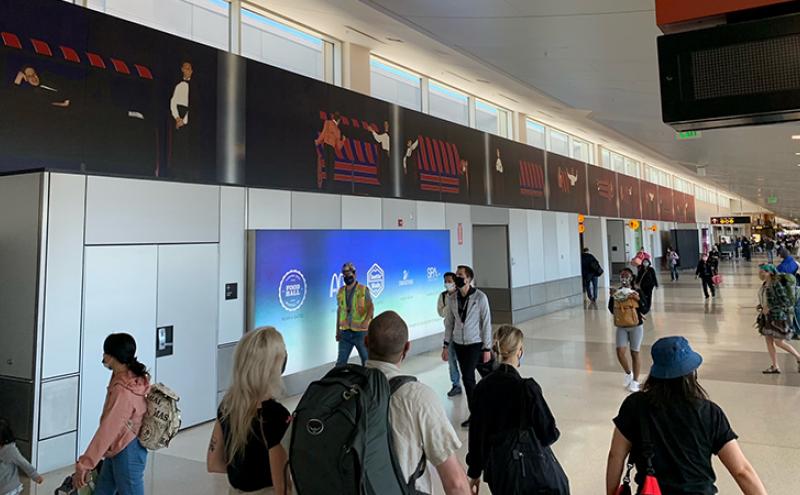If you’ve contemplated the meaning behind Seattle-Tacoma International Airport’s (SEA) mysterious “High Wire” painting or wonder what the connection is between a magic trick and an airport you aren’t alone. The infamous piece has mystified and intrigued passersby since it was first installed on the D Concourse in November 1993.
The answer is actually very simple. Traveling by air is a magical experience. When traveling by air, people get into a long cylindrical box (the aircraft) and in a matter of hours, they are transformed magically from one city to another. The 180-foot-long mural, currently located on the A Concourse over security checkpoint 2, features a sequence of 11 images in different stages of a vaudeville performance. Passersby can view a magician and his assistant performing a magic trick that begins in one place and ends at another, similar to the act of flying or traveling.
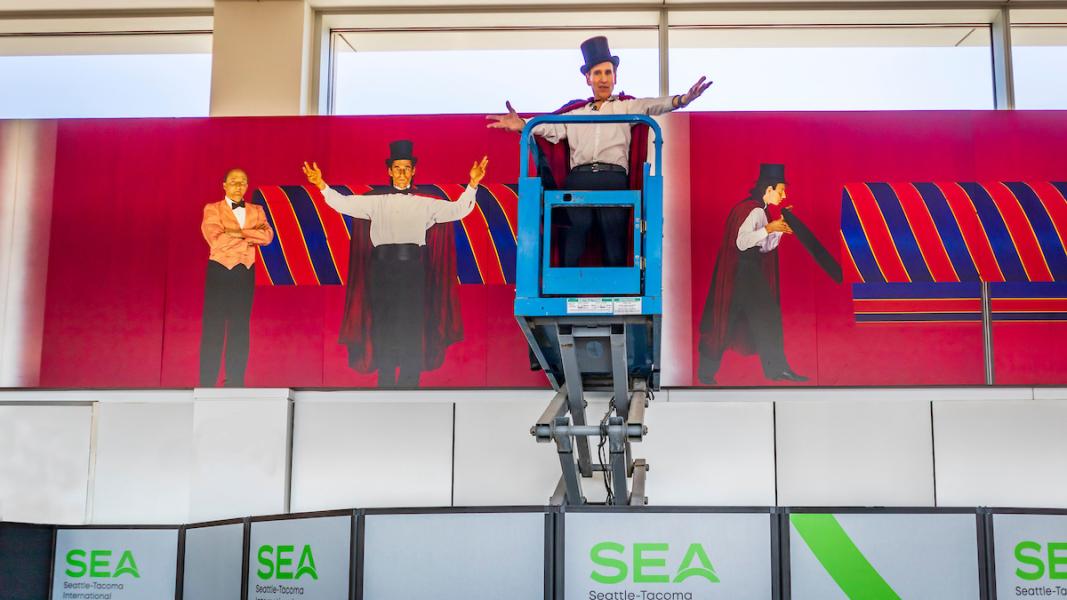
The magic of air travel
How did SEA’s most talked about painting come to be? Back in the 1990s, artist Michael Fajans was given free creative rein by the Port of Seattle to develop a piece for SEA Airport. The subject matter and specs were up to him. When he attended a magic show at a Capitol Hill party featuring Seattle magician Jonathan Docter, inspiration struck. After the performance Fajans approached Docter and proposed the magic-inspired painting, explaining magic’s connection to the act of flying. With Docter on board, the idea began to take shape.
According to Docter, who was ultimately depicted in the iconic piece, “In (both magic and air travel) there is a transformation sort of like teleportation. When something is transported from one place to another, in this case with a jet plane, that is considered magic, even today.”
Whether it’s an airplane or magic, there is a method by which it happens.
“When a magician does a magic trick we see it is an illusion; we see something happening that should not be able to happen in our physical world, but a magician is doing little things behind the scenes that make it happen,” Docter said. “That's how flying works through the mechanics behind it. That’s what makes it interesting.”
“High Wire,” which remains an essential part of SEA’s public art collection, is a result of that conclusion. In the painting, the viewer can see a magic trick unfolding around an empty magic box, performed by Docter and his magician’s assistant, portrayed by Seattle local Denny Warshal. It can be viewed in two ways, adding to its mystique. Looked at one way, a figure eventually appears out of the magic box or, if viewed in the opposite direction, the figure disappears in the box.
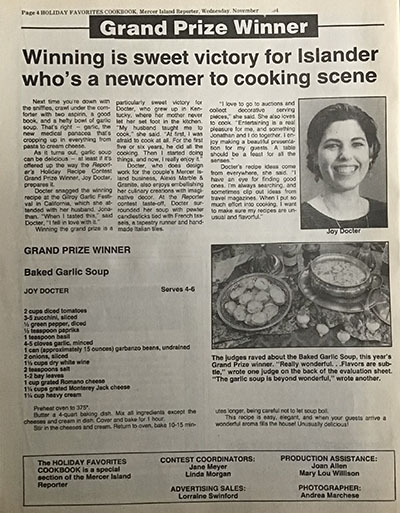
Magical beginnings
Docter’s passion for magic flourished in “High Wire” but he first discovered magic as a child when his mother signed him up for a summer magic course at a community center. The instructor saw his potential and later offered him private lessons; he also joined an entertainment group that performed at local hospitals. Over the years, he continued to pursue magic as a professional hobby, performing at the occasional child’s birthday party or event, but his transition from hobbyist to career magician all started with a flavorful recipe.
In 1981, Docter’s wife entered a recipe contest at their local community center sponsored by the Mercer Island Reporter. She won the grand prize for her dish — baked garlic soup. The prize? Two Southwest Airlines tickets. The couple chose Las Vegas as their vacation destination and attended a gift show convention. At the convention, they came across a magic equipment company selling tricks that captured their interest. On a whim, they placed a $200 order. They set up a little magic booth at Seattle Center selling the tricks they had purchased. On their first day, they made around $20. But the next day they sold a little more, and their success grew and grew until eventually their business, Uncle Stinky’s Magic and Entertainment, became a full-time job.
That magical background led to Docter’s chance meeting with Fajans, who would introduce him to an international audience as “the magician at the airport.”
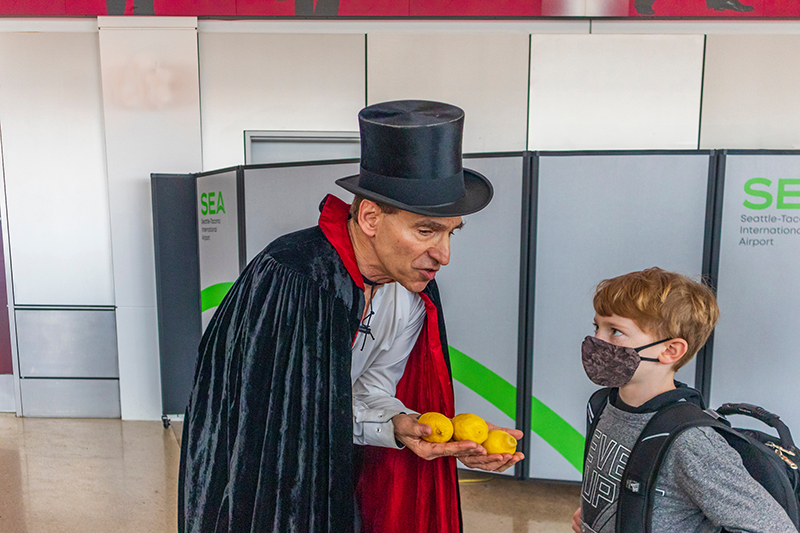
Creating an illusion
The inspiration for the illusion featured in “High Wire” came from an old magic book dated back to the late 1800s. In the illusion, the magician and assistant spun around an empty box and someone appeared inside. To make it more visually appealing, Fajans commissioned a custom box painted with black and red stripes. The illusion would not just need to be depicted successfully in the painting; it needed to actually be performed, and it needed to be exciting for an audience. During the 1993 “High Wire” launch event on SEA’s D Concourse, Docter performed the illusion live in front of an audience, with Fajans’ son Pepper acting as magician’s assistant.
To develop the painting, over the course of a couple of months, Fajans captured Docter performing the illusion in a series of photographs taken in Fajans’ Pioneer Square studio. “We'd do one scene at a time, one depiction at a time, and then work it out. I’d change my position a little if we needed it to be more dramatic,” he said.
Fajans used the photographs to create photorealistic paintings. The process of creating these hyper-realistic depictions is a difficult one and requires countless layers of airbrushed paint to produce varying degrees of shadow and textures.
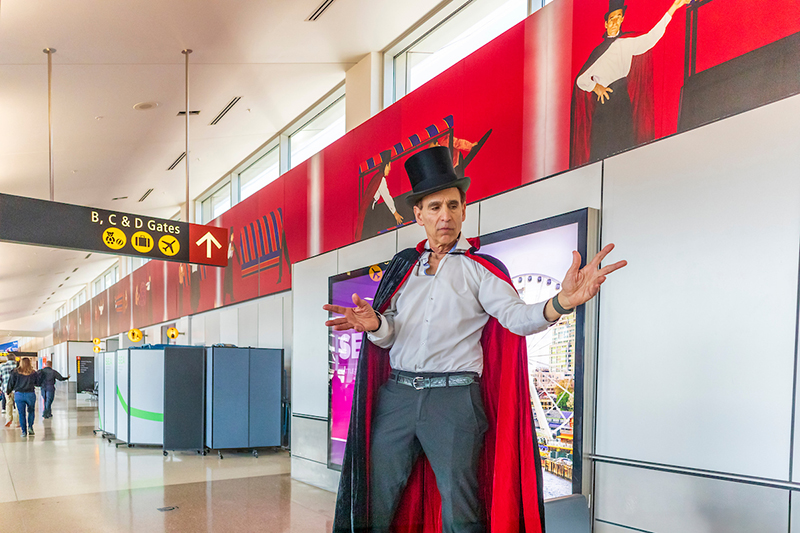
The magician at the airport
Docter said viewing the painting for the first time left him speechless. “When you go through the process, you don’t have any concept of what it’s going to look like at the end. I was blown away.”
Docter and Fajans remained close after “High Wire” was completed until Fajans’ tragic death in a motorcycle crash in 2006. Although Docter isn’t aware of Fajans’ intent in naming the piece “High Wire,” he imagines somebody delicately balancing as they walk carefully across a wire high above a circus tent, making their way from one place to another.
“What I’m imagining is that Michael saw a connection between a magic act starting in one place and ending in another, and a trapeze artist or tightrope walker moving from one place to another,” he said. “I love the ambiguity. You don’t have to understand everything to enjoy it.”
The painting, seen by millions of travelers from around the world each year, would be life-changing for Docter. Even 30 years later, walking down the street out of his magician’s costume, he gets recognized. It also gives him an edge when booking magician jobs; the event is able to advertise that the “magician at the airport” will be performing. “It’s helped me transform a professional hobby into a full-time business.”
When he’s flying in or out of SEA, Docter likes to make a special stop to look at the painting that changed his life. “So many times people look at me like “Is that him? That guy looks like that magician.”’
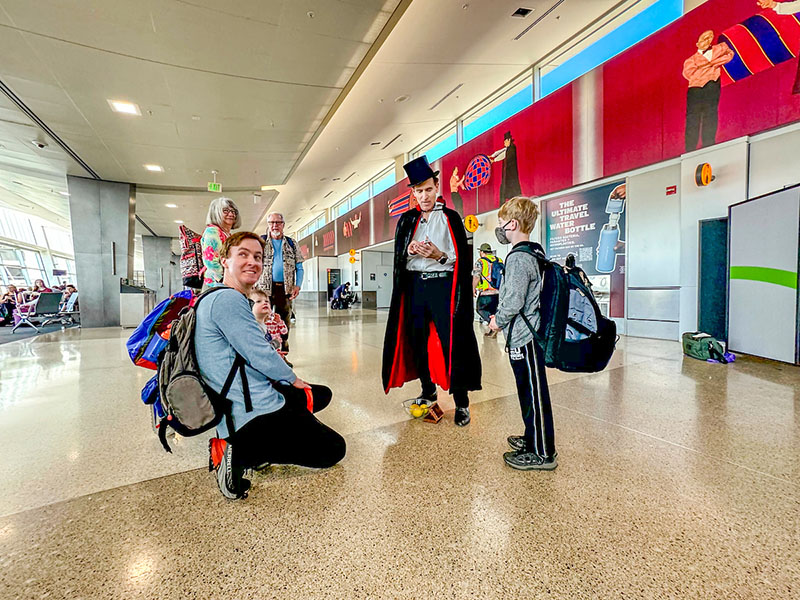
Something to talk about
Docter visited “High Wire” in its A Concourse location for the first time this year (it was moved from the D Concourse in 2021 to a safe location above eye level and out of passengers’ paths), dressed in the same cape and top hat he wore in the painting. He performed a few magic tricks for a small audience.
Thirty years after its installation, “High Wire” remains one of the most talked about pieces in SEA’s public art collection. Whether people love it or hate it, many have taken to social media to discuss the painting or even engaged with Port Public Art Program Manager Tommy Gregory on it directly.
Some are unsettled by Docter’s direct eye contact with his audience in the painting, but Docter said eye contact is how he builds a connection with his audience.
“Michael (Fajans) and I didn't discuss the eye contact, but when I'm on stage I like to connect to my audience. I’m not invisible. I know my audience is there, and my best shows are when I have this direct communication with them and react to that. My show is always a little different depending on the reaction. I feed off of the crowd as most performers do.”


